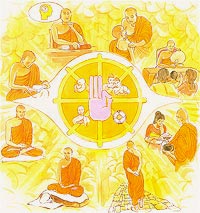Posted by: site admin @ 6:56 pm










 & vegetables
& vegetables 





























 Plants
Plants  in pots
in pots 
 To live like free birds
To live like free birds 

 for Hunger along with Meditative Mindful Swimming
for Hunger along with Meditative Mindful Swimming  to Attain Eternal Bliss by Eternal,Glorified,Friendly,
to Attain Eternal Bliss by Eternal,Glorified,Friendly, from Christianity,Islam, Buddhism,Judaism,Hinduism,
from Christianity,Islam, Buddhism,Judaism,Hinduism,Eternal Glorified Friendly Benevolent Compassionate AWAKENED ONE’s UNIVERSE IS WITHIN YOU.
his 29th year he renounced the worldly life and exchanged his princely
career for that of a homeless mendicant. After six years of hard
striving he at last attained his goal: deliverance from the round of
rebirths, or Samsara.
there is one person whose birth into this world is for the welfare and
happiness of many, out of compassion for the world, for the gain and
welfare and happiness of gods and humanity. Who is this one person? It
is the Tathâgata, who is a Worthy One, a Fully Awakened One ~ Anguttara
Nikaya”
“Hard is it to be born a man; hard is the life of
mortals. Hard is it to gain the opportunity of hearing the Sublime
Truth, and hard to encounter is the arising of the Buddhas.~ Dhammapada
182″

Verse 182. Four Rare Opportunities
Human birth is hard to gain,
hard for mortals is their life,
to come to Dhamma True is hard,
rare the Buddha’s arising.
Explanation: It is rare that one is born a human being, in
this cycle of rebirth. It is difficult and rare to get the opportunity
to hear the good teaching, It is, indeed, rare for the birth of a
Buddha to occur.
no external refuge; with the Dhamma as your island, the Dhamma as your
refuge, seeking no other refuge ~ Maha Parinibbana sutta”
“Driven
by fear, men go for refuge to many places — to hills, woods, groves,
trees and shrines. Such, indeed, is no safe refuge; such is not the
refuge supreme. Not by resorting to such a refuge is one released from
all suffering. He who has gone for refuge to the Buddha, the Teaching
and his Order, penetrates with transcendental wisdom the Four Noble
Truths — suffering, the cause of suffering, the cessation of suffering,
and the Noble Eightfold Path leading to the cessation of suffering.
This,
indeed, is refuge secure. By seeking such refuge one is released from all
sorrow.
~ Dhammapada 188-192″
 |
Verse 188. Fear Stricken Masses
Explanation: Human beings who tremble in fear seek refuge |
 |
Verse 189. Those Refuges Do Not Help
Explanation: These are not secure refuges. The are not the |
 |
Verse 190. Seeing Four Noble Truths
Explanation: If a wise person were to take |
 |
Verse 191. The Noble Path
Explanation: The four extraordinary realities are suffering; |
 |
Verse 192 The Refuge That Ends All Suffering
Explanation: This refuge in the Triple Refuge is, of course, |
have heard that on one occasion the Blessed One was staying at Varanasi
in the Game Refuge at Isipatana. There he addressed the group of five
monks:
are these two extremes that are not to be indulged in by one who has
gone forth. Which two? That which is devoted to sensual pleasure with
reference to sensual objects: base, vulgar, common, ignoble,
unprofitable; and that which is devoted to self-affliction: painful,
ignoble, unprofitable. Avoiding both of these extremes, the middle way
realized by the Tathagata — producing vision, producing knowledge —
leads to calm, to direct knowledge, to self-awakening, to Unbinding.
what is the middle way realized by the Tathagata that — producing
vision, producing knowledge — leads to calm, to direct knowledge, to
self-awakening, to Unbinding? Precisely this Noble Eightfold Path: right
view, right resolve, right speech, right action, right livelihood,
right effort, right mindfulness, right concentration. This is the middle
way realized by the Tathagata that — producing vision, producing
knowledge — leads to calm, to direct knowledge, to self-awakening, to
Unbinding.
this, monks, is the noble truth of stress:1 Birth is stressful, aging
is stressful, death is stressful; sorrow, lamentation, pain, distress,
& despair are stressful; association with the unbeloved is
stressful, separation from the loved is stressful, not getting what is
wanted is stressful. In short, the five clinging-aggregates are
stressful.
this, monks, is the noble truth of the origination of stress: the
craving that makes for further becoming — accompanied by passion &
delight, relishing now here & now there — i.e., craving for sensual
pleasure, craving for becoming, craving for non-becoming.
this, monks, is the noble truth of the cessation of stress: the
remainderless fading & cessation, renunciation, relinquishment,
release, & letting go of that very craving.
this, monks, is the noble truth of the way of practice leading to the
cessation of stress: precisely this Noble Eightfold Path — right view,
right resolve, right speech, right action, right livelihood, right
effort, right mindfulness

system of penalties the Buddha worked out for the rules is based on two
principles. The first is that the training aims primarily at the
development of the mind. Thus the factors of intention and perception
often determine whether or not a particular action is an infringement of
a rule. For instance, killing an animal accidentally is, in terms of
the mind of the agent, very different from killing it purposefully, and
does not count as an infringement of the rule against killing.
are a few rules where the factors of intention and perception make no
difference at all — such as in the rule forbidding a monk to drink
alcohol — but they almost always deal with situations where one would be
expected to be mindful and perceptive enough to know what’s going on,
and so these rules too help in the training of the mind.
any event, the system of analyzing each offense into the factors of
effort, object, perception, intention and result shows how adherence to
the rules leads directly to the development of concentration and
discernment. If a monk is careful to view his actions in terms of these
factors, he is developing mindfulness, an analytical approach to events
in the present, and persistence. These are the first three factors for
Awakening, and form the basis for the remaining four: rapture, serenity,
concentration and equanimity.
second principle used in determining penalties is based on the Buddha’s
observation to Ananda, one of his chief disciples, that friendship and
companionship with the good is the whole of the religious life. Anyone
who approaches the Dhamma seriously should be wise enough to realize
that without the opportunity of associating and learning from people who
are experienced on the path, it is well nigh impossible to make any
progress on one’s own. The monks are thus expected to value their good
standing vis a vis the well-behaved members of their group, and so the
system of punishments worked out by the Buddha revolves entirely around
affecting the offender’s status within the Community.
a monk breaks one of the four most serious rules — the pārājikas
(Pr)defeat — he is expelled from the Community for life. If he breaks
one of the next most serious classes of the rules — the saṅghādisesas
(Sg)entailing Communal meetings — he is put on probation for six days,
during which time he is stripped of his seniority, is not trusted to go
anywhere unaccompanied by four other monks of regular standing, and
daily has to confess his offense to every monk who lives in or happens
to visit the monastery. At the end of his probation, twenty monks have
to be convened to reinstate him to his original status.
next three levels of rules — nissaggiya pācittiya (NP)entailing
forfeiture and confession, pācittiya (Pc)entailing confession, and
pāṭidesanīya (Pd) — entail simple confession to a fellow monk, although
the NP rules involved an article that has to be forfeited — in most
cases temporarily, although in a few cases the object has to be
forfeited for good, in which case the offender has to confess his
offense to the entire Community.
a monk commits an offense and refuses to undergo the penalty, the
Community may decide how seriously they take the matter. Since there is
no monks’ police beyond the individual’s conscience, it may often happen
that no one else knows of the offense to begin with, and nothing is
done. If however it becomes common knowledge, and the Community regards
it as a serious matter, they should talk privately with the monk to help
him see the error of his ways. If he is recalcitrant, they may strip
him temporarily of his status, either by censuring him, stripping him of
his seniority, driving him from the Community, or suspending him from
the Order of monks as a whole. If the offender sees the error of his
ways and reforms his behavior accordingly, the Community may return him
to his former status.
of course there may be some hardened souls among the monks who are
unfazed by punishments of this sort, but we should note that the Buddha
saw no use for physical coercion in enforcing his rules. If a monk had
to be physically forced into abiding by the training, his heart wouldn’t
be in it, and there is no way that he could benefit from it. Such monks
the Buddha considered beyond the pale, although he allowed them to stay
on in the Community in hopes that eventually their conscience would get
the better of them. In the meantime, the law of karma would guarantee
that in the long run, they would not be getting away with anything at
all.
final two levels of rules in the Patimokkha do not give a particular
penalty. The sekhiya (Sk) trainingsrules — dealing primarily with
etiquette — simply state that one should work at following them. The
Sutta Vibhanga explains that if one oversteps them out of disrespect,
one should confess the fact. The adhikaraṇa samatha (As) the settlement
of issues rules are not so much rules as they are principles to follow
in dealing with issues that arise in the Community. If monks try to
settle an issue without following these principles, their decision is
invalid, and they must confess their wrongdoing to other monks who took
no part in the decision.
Monastic Code IChapter 1PatimokkhaThe Pāṭimokkha is available to us in
several recensions, some in Indic languages,others in Tibetan or Chinese
tran…

Gardening Tips
How to Get Started With Low-Light Plants

If you don’t have much room for a backyard garden or have
less-than-ideal growing conditions indoors, you might be feeling like
gardening isn’t an option. Fortunately, that’s not the case at all.
You can have a thriving, easy-care garden with low-light plants.
Learn a bit about why low-light plants could be a fit for you, along
with how to set up your indoor garden for success. From tabletop
houseplants to mushrooms, microgreens, and more, you can put your green
thumb to work inside without missing a beat.
Why Choose Low-Light Plants?
Not every gardener has perfect planting conditions indoors and out.
While there are plants that grow well without being in direct sunlight,
it can be tricky finding the sweet spot in shadier situations.
The good news is that there are many plants that grow well in
low-light conditions, making them a good choice for beginner gardeners
or those who prefer more low-maintenance gardening.
Even if you have a north-facing patio or window sills, rest assured
you can find low-light plants well-suited to the space you have. You can
perk up a porch with a hanging basket (or two) or add a touch of
greenery to your living room. Pairing your plants with the natural light
you do have can mean the difference between plants that flourish and
ones that flop.
3 Tips for a Thriving Indoor Garden
While indoor plants can be easier to maintain than an outdoor garden,
it still pays off to put in the time and effort to get it started
right. Here are three ways you can set up your garden for success.
1. Pick the Perfect Containers
Container size might not seem like a big deal, but trust us when we
say it is. Pint-sized pots may be great in the beginning, but your plant
can outgrow them quickly. If you notice your plant’s roots are breaking
through the pot or your plant is constantly tipping over and making a
mess, it’s time for an upgrade. Depending on how quickly your plants
grow, be ready to transplant them into bigger pots once a year.
In the event your plants outgrow your indoor space, consider moving them outside. Back to the Roots Fabric Raised Garden Bed
is portable, made from durable felt, and comes together in minutes to
give you extra room for fruits, veggies, and more when you need it.
2. Lay the Foundation
Like their outdoor counterparts, low-light indoor plants benefit from high-quality organic potting soil.
The right potting mix will have an array of organic matter and
beneficial bacteria to help your plant’s roots get the nutrients they
need to thrive. And because it’s organic, you’ll be keeping pesticides
and other chemical nasties off your plate and out of your home.
If you feel like your plants need a boost, consider picking up organic fertilizer at your local Home Depot or Walmart Garden Center.
The right fertilizer will support your plant’s growth right from the
start and improve nutrient absorption and overall soil quality.
3. Be Mindful of Watering
An indoor garden
doesn’t benefit from nature’s rain showers, so you must make sure to
water your plants adequately. If you’re unsure whether your plant is
ready for a drink, test the soil moisture by sticking your finger in it.
If it feels moist but not soaked , you and your plant are good to go.
Overwatering can be just as much of an issue for your plants as
underwatering. Even though it might be tempting to water them on a
schedule, you could run the risk of giving your plants more than they
need. Using containers with drainage holes is another way you can avoid
drowning your plants.
Don’t worry if you don’t get it quite right at the beginning of your
gardening adventures. Things like where you live and humidity levels in
your home can influence how much water your plant friends will need
through the season.
Choosing Your Low-Light Plants

Low-light conditions don’t have to be a barrier to having an indoor
garden you and your family love. With so many plants to choose from, you
have plenty to explore and experiment with. Browse this list of the
best low-light plants to grow indoors to get started.
Microgreens
Interested in growing your own food?
One of the simplest ways to begin is with microgreens. Because they
only need a few hours of direct sunlight every day, they’re perfect for
low-light environments. Plus, you get to harvest your microgreens in a matter of days, not weeks!
You can add your home-grown microgreens to sandwiches, soups, and salads. They’re chock-full of antioxidants too (up to 40 times the nutrients compared to mature plants), and make a great addition to a healthy lifestyle.
To get started in minutes, check out a Back to the Roots Microgreens Grow Kit,
where you can choose from three different microgreen varieties. It even
comes with a white ceramic planter, so your greens will fit right into
your decor.
Because Back to the Roots uses only 100% certified organic and
non-GMO domestically grown seeds, you can relax knowing you’re giving
your family the best quality microgreens in as few as seven days.
Mushrooms
Mushrooms might be the ultimate low-light plant to include in your
indoor gardening projects as they don’t require any sun exposure. In
fact, they prefer dark, humid environments. Unlike other plants on this
list, your mushrooms will be happiest tucked away in a dark corner of
your kitchen (like inside a cabinet).
The easiest way to start growing mushrooms is with a kit. Like all of our grow kits, the Back to the Roots Mushroom Grow Kit
gives you everything you need to kick off your mushroom garden in just
10 days. You’ll receive a spray mister, mushrooms spawn, and a
downloadable curriculum so kids can learn all about the fascinating
science behind mushrooms and how they grow.
Fruits and Vegetables
While some fruits and vegetables aren’t entirely suited to low-light
areas, you can still have a successful indoor garden if you make some
accommodations.
A few options that grow successfully indoors:
To help your plants grow their best, be sure and pick up an LED grow light. It can mimic the sun’s natural rays and make it possible for you to enjoy freshly picked fruits and vegetables year-round.
Growing fruits and vegetables inside can be made even simpler with a hydroponic gardening system.
This fun and easy system is entirely self-contained, so you never have
to worry about overwatering or maintaining soil quality.
Houseplants
Low-light houseplants are a terrific entry point for gardeners who
don’t feel ready to start growing their own food but want to bring
nature indoors. You can even try growing some of them in a terrarium.
While there are many low-light plants you can grow inside, these are some of our favorites. We’ve included their botanical and common names when possible:
- Pothos or Devil’s Ivy (Epipremnum aureum)
- Peace Lily (Spathiphyllum)
- Philodendron
- Snake plant or Mother-in-Law’s Tongue (Sansevieria trifasciata)
- Chinese Evergreen (Aglaonema commutatum)
- ZZ Plant (zamioculcas zamiifolia)
- Dumb Cane (Dieffenbachia)
- Prayer Plant (Maranta leuconeura)
- Lucky Bamboo (Dracaena sanderiana)
- Swiss cheese plant (Monstera Deliciosa)
- Spider plant (Chlorophytum comosum)
- Zebra or rattlesnake plant (Calathea)
- Parlor palm (Chamaedorea elegans)
- Staghorn fern (Platycerium bifurcatum)
- Bird’s nest fern (Asplenium nidus)
- Succulents
- Bromeliads
- Peperomia
- Cast Iron Plant (Aspidistra)
Start an Indoor Garden With Low-Light Plants

Low-light plants make it easy to start an indoor garden and grow your
own food without perfect lighting conditions. Growing your own food
also allows you to connect with nature in new ways while supplying you
and your family with organic nourishment all year long.
For more ways to grow fruits and vegetables indoors and out, keep browsing our Back to the Roots blog.

